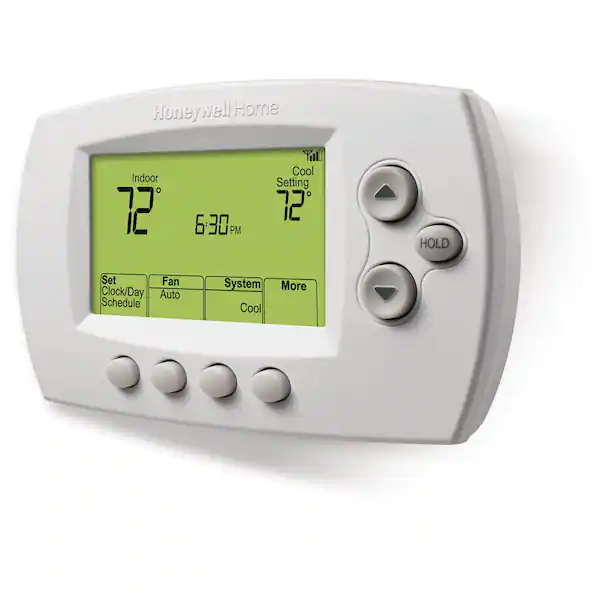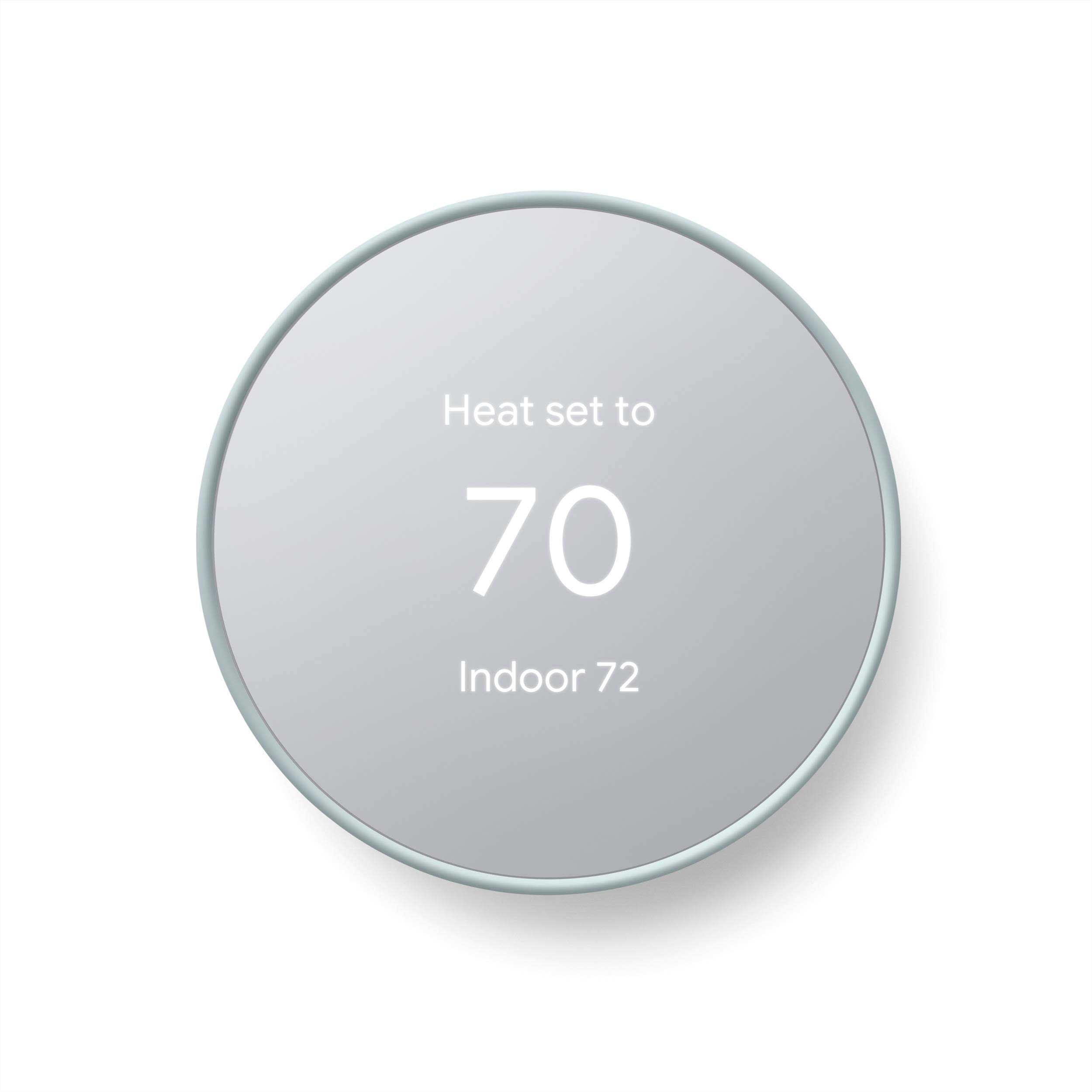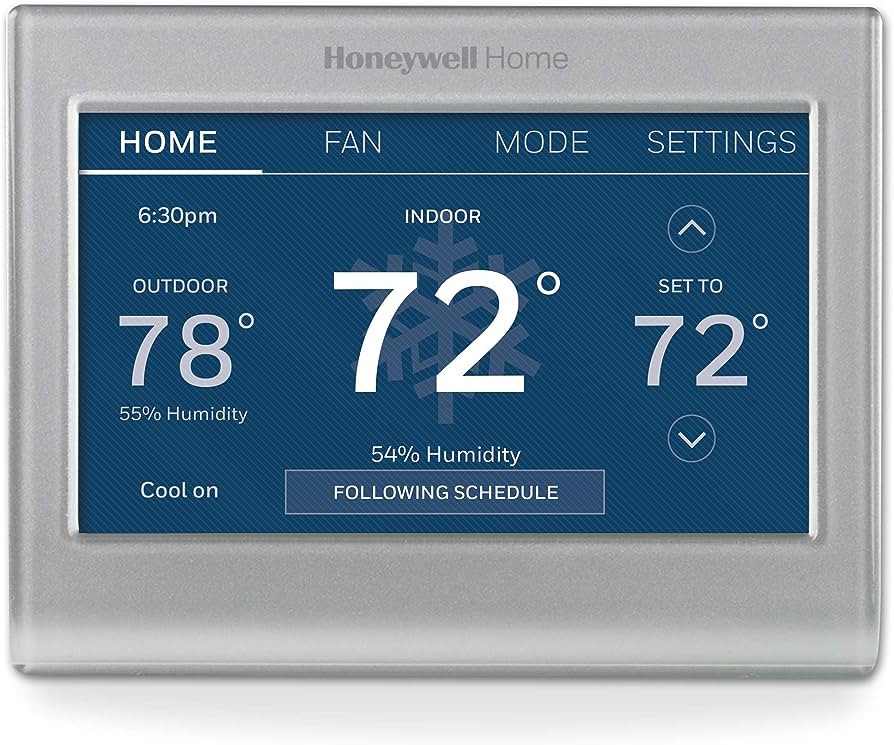
Honeywell Home RTH6580WF Wi-Fi 7-Day Programmable Thermostat
- Wi-Fi Connectivity: Allows for remote access via smartphone or computer, and it is compatible with a free smartphone app for iPhone, iPad, and Android operating systems.
- 7-Day Programming: Provides the flexibility of programming different temperature settings for each day of the week.
- Large, Easy-to-Read Digital Display: Features a clear display for easy readability.
- Real-Time Clock: Includes a real-time clock for accurate timekeeping.
- Permanent/Temporary Hold: Allows users to override the programmed schedule with a temporary hold or make permanent temperature adjustments.
- Precision Accuracy: Provides precise temperature control for enhanced comfort.
- Intelligent Alerts: Offers high/low temperature notifications and loss of connection to Wi-Fi network alerts.
- Works with Smart Home Ecosystems: Compatible with smart home platforms such as Alexa, Google Assistant, Samsung SmartThings, IFTTT, and more.
- Energy Saving Mode: Includes an energy-saving mode to help conserve energy.

Google Nest Thermostat – Smart Thermostat for Home – Programmable Wifi Thermostat
- Wi-Fi Connectivity: Allows for remote access via smartphone or computer, providing convenience and control over the thermostat’s settings.
- 7-Day Programming: Provides the flexibility of programming different temperature settings for each day of the week, allowing for customized comfort and energy savings.
- Energy Saving: The thermostat can turn itself down to save energy when you leave the house, contributing to reduced energy consumption and cost savings.
- Large, Easy-to-Read Digital Display: Features a clear display for easy readability, ensuring that the thermostat’s information is easily accessible.
- Real-Time Clock: Includes a real-time clock for accurate timekeeping, enabling precise scheduling of temperature adjustments.
- Precision Temperature Control: Provides precise temperature control for enhanced comfort, maintaining the desired temperature levels within the home.
- Works with Smart Home Ecosystems: Compatible with smart home platforms such as Alexa, Google Assistant, and more, allowing for seamless integration into a smart home environment.

Honeywell Home RTH9585WF Wi-Fi Smart Color Thermostat
- Wi-Fi Connectivity: Allows for remote access via smartphone or computer, providing convenience and control over the thermostat’s settings.
- 7-Day Programming: Provides the flexibility of programming different temperature settings for each day of the week, allowing for customized comfort and energy savings.
- Energy Saving: The thermostat can turn itself down to save energy when you leave the house, contributing to reduced energy consumption and cost savings.
- Large, Easy-to-Read Digital Display: Features a clear, customizable color display for easy readability, ensuring that the thermostat’s information is easily accessible.
- Real-Time Clock: Includes a real-time clock for accurate timekeeping, enabling precise scheduling of temperature adjustments.
- Permanent/Temporary Hold: Allows users to override the programmed schedule with a temporary hold or make permanent temperature adjustments.
- Precision Temperature Control: Provides precise temperature control for enhanced comfort, maintaining the desired temperature levels within the home.
- Intelligent Alerts: Offers high/low temperature notifications and loss of connection to Wi-Fi network alerts.
- Works with Smart Home Ecosystems: Compatible with smart home platforms such as Alexa, Google Assistant, and more, allowing for seamless integration into a smart home environment.
How to choose best Wi-Fi thermostat
To choose the best Wi-Fi thermostat, consider the following factors:
- Compatibility: Ensure that the thermostat is compatible with your HVAC system and wiring.
- Features: Look for features such as 7-day programming, energy-saving modes, and remote access via smartphone or computer.
- Ease of Use: Choose a thermostat with a user-friendly interface and easy-to-read display.
- Smart Home Integration: Consider whether the thermostat is compatible with your smart home ecosystem, such as Alexa, Google Assistant, or Apple HomeKit.
- Price: Compare prices and features to find a thermostat that fits your budget.
Some of the top-rated Wi-Fi thermostats on the market include the Amazon Smart Thermostat, the Google Nest Thermostat, and the Honeywell Home RTH6580WF Wi-Fi 7-Day Programmable Thermostat. It’s recommended to research and compare different models to find the best fit for your needs and preferences.
Mains voltage or low voltage thermostat?
A thermostat connected to the mains supply is typically used to control wall-mounted electric heaters. Low voltage thermostats control central heating and air conditioning systems (including centralized systems using a gas air heater).
- Mains voltage thermostats are used for individual electric heaters
- Low voltage thermostats are used in central heating/cooling systems to control the central gas heater
Single pole or double pole?
A single pole thermostat is a system that you cannot fully turn off, it only has a “low” setting [for heating]. Such a thermostat is usually connected to the mains supply using two wires. Of course, you can minimize the heating value, but if the temperature in your house reaches that minimum, the thermostat will still turn on heating. The heating system can only be completely turned off by disconnecting it from the power supply. This type of heating system is suitable, for example, for cottages, where residents visit occasionally, as it guarantees that the pipes in your house do not freeze.
A double pole thermostat is used in heating systems that can be completely turned off. Such thermostats are usually connected using 4 wires. The system has a circuit that can be completely de-energized – just like an electrical appliance equipped with an “off” switch. Such devices work well where there is a need to completely turn off the system at night or in a certain season – for example, in summer country houses. Sometimes building codes require heating systems of precisely this type.
Wall-mounted or built-in?
It depends on the situation. A built-in control unit is convenient to install if the wall finishes are already complete. However, a wall-mounted thermostat allows you to better control the room temperature parameters, it is more convenient, and there is also a much wider choice of such models on the market. An electronic thermostat provides more precise system control, and also helps save electricity – and thus your money.
Mechanical or electronic?
A mechanical thermostat has a relay with two metal plates that bend when the temperature changes. As a result, heating is switched on and off in the range of 1 to 3 degrees from the set temperature value.
An electronic thermostat has a digital temperature sensor that more accurately determines the temperature. The sensor tracks the air temperature in the room within 1 degree or less from the set value. Certain modern thermostat models are equipped with a programming function – so you can control the climate in your home by setting different temperature values for different times of the day or days of the week.
Energy saving?
If energy savings matter to you, keep in mind that the greater the temperature fluctuation range from the set value, the more energy is wasted. In this case, both electricity bills increase and home comfort decreases. On the other hand, programmable electronic thermostats can help you save up to 28% on heating costs. Over time, these savings will more than pay for the higher cost thermostat.
FAQ
Can I install a wall-mounted thermostat to control my system if it already has a built-in thermostat?
- Of course. To override the built-in thermostat settings, you need to set it to the maximum value, and then adjust the room temperature using the wall-mounted thermostat. There are exceptions: a wall-mounted thermostat is not recommended for use with some heater brands.
Where is the best place to install a wall-mounted thermostat?
- The thermostat is installed on an interior wall away from drafts and direct sunlight, as well as away from any household appliances that could affect the set temperature value. Also make sure that the airflow near the thermostat is not blocked by furniture, shelves or decorative elements.
Install the thermostat on the opposite wall from the heater, at a height of about one and a half meters above the floor. If there are two heaters in a large room, place the thermostat in the center between them.
Can I control all the heaters in the house with one thermostat?
- You can definitely control the climate throughout your entire house with one thermostat – provided you have a centralized heating system installed (this is precisely the kind of systems our company offers). If you have several separate heaters in your house, then each of them will need a separate thermostat.
I am not satisfied with how my wall-mounted thermostat works. What should I do?
- We recommend replacing the thermostat (if the heating system itself is in order – it should be checked first, primarily for clogged filters). When the accuracy of the thermostat decreases, its efficiency decreases – and the room temperature may increase.
Leave a Reply